
Army Cadet Volunteers 2006
During the early part of 2006 the serving trust chairman was contacted by Cpl. David Ridley of the 4 th Platoon (Wellington). Cpl Ridley has come across our website and was interested in the "William Riley" project. During a number of telephone conversations we were offered the services of the unit as volunteer workers. Each year the unit travels to different community projects throughout the country offering volunteer services. The trust was grateful for the having the opportunity to have the cadet volunteers helping with the restoration for a day and mutually agreed that the unit would on site on the 22ndJuly.
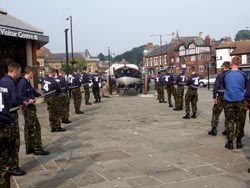
The day the cadets arrived coincided with Whitby's annual lifeboat regatta and the unit was first tasked with moving the Robert and Ellen Robson from the cargo storage facility on the wharf to a more prominent position in the town. Once the cadets had pulled the lifeboat up onto the pavement outside the information centre I used the opportunity to get a group photograph in front of the lifeboat.
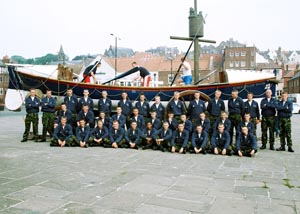
If anything the Robert and Ellen Robson would have given them an idea of what we are hoping to achieve with the William Riley, even if the former lifeboat is currently going through the early stages of the restoration. Seeing the William Riley for the first time in her present state must have been quite a shock for the cadets after seeing the Robert and Ellen Robson, they are perhaps fortunate that they were not present when the lifeboat was first discovered down in Barnstaple!
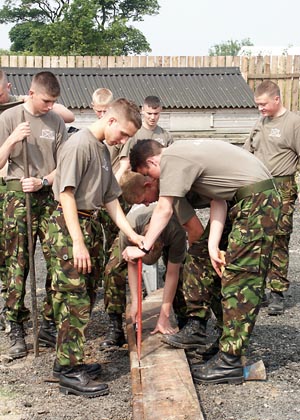
The cadets were split into small groups and given specific tasks, each task was chosen as something different for the cadets to experience. One of the groups was given the task of working with the keel iron still attached to the old keel from the Edward & Eliza an ex lifeboat from Northumberland. Although an old piece of wooden keel, the keel iron itself was extremely reluctant to be separated from the keel. It was quite a task and required some effort for the cadets to inch along the keel. It was perhaps quite fortunate that there were sufficient cadets to take it in turns!
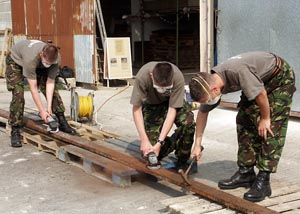
With the keel iron eventually removed the next task was to clean it removing the many years of accumulated rust. Working in pairs the cadets first chipped away any large loose rust particles using just hammers. With the rust removed the cadets used electric grinders to remove the finer rust leaving the keel iron looking clean and shiny. The iron could then be treated with a suitable rust preventative. It was not an easy task to complete as to in doing so the cadets had to wear the appropriate safety equipment and it was compounded by the heat of a summers day.
The lifeboat could be manned by up ten lifeboat personnel and ten oars. The lifeboat was found without any oars, as one would expect after so long especially considering the conversions the vessel endured throughout her lifetime. In keeping with the recycle theme the trust had secured a number of wooden beams from the old lifeboat station as it was dismantled. These were immediately put aside for use in the making of replicated oars.
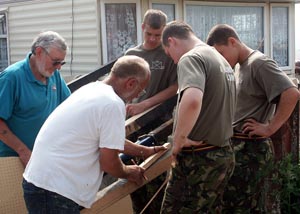
As no template exists for the original oars from the William Riley it was felt that as a similar class of lifeboat, an oar from the Robert and Ellen Robson could be used as a template for the replacement oars. It was not as simple as it sounds, as the wooden beams were square as opposed to the round shape needed for the oars. Thankfully one of the trustees, Dave Wharton had a vast experience having served as the harbour joiner for a number of years and he was more than happy to offer the cadets specialist advice. Dave specialises in working with wood and he was suitably placed to make a rather unique too that was instrumental in helping guide the cadets in getting a better rounded edge from the original square beam.
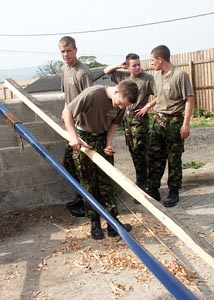
Once the wood was suitably scribed a number of cadets were divided into two individual teams taking to the task well. Using what would today be deemed 'old' tools the cadets were soon engrossed in their work. It was not long before the outline of the oars were noticeable. The cadets were as pleased as Dave was with their progress and it was quite enjoyable watching as a photographer and trustee as the cadets made significant progress. After a short break for lunch each of the cadets was swapped round to one of the alternative jobs. This would give each of the cadets a greater understanding of what is involved with the restoration project. The trust is extremely grateful for the help and support from the army cadets and we feel they have helped to move the project along.
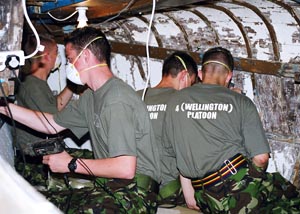
As well as the major tasks the cadets were given smaller jobs working with the hull itself. Working inside the fore and aft whaleback boxes the cadets helped remove the the many layers of paint. The cadets had the use of an electric paint stripper and had to cope with the heat of the day and protective clothing but even so they maintained their enthusiasm for the task.
The Wooden Sheeting For The Templates
A selection of wooden sheeting had been set aside for use as wooden templates to be used in inverting the lifeboat and set out on easels so that the cadets could work with them.

The trust working party had made up a template in advance of the cadets arrival which they could utilise for the sections they were going to cut out. It took quite a few of the cadets to complete marking each of the sheeting. Once marked the task of cutting the sheeting was split between the cadets responsible for cutting the excess wood away.
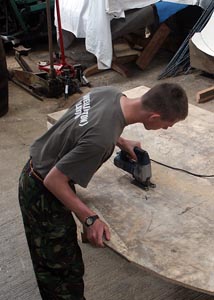
Afterwards the cadets were able to further reduce the sheets with some finer cutting. With the chosen sheets cut they could then be offered up to the lifeboat hull in an effort to gauge how close the cuts were to the hull itself. Any cuts that could be improved upon received the necessary treatment. All in all the cadets did extremely well and as trustees we hope they enjoyed the experience of working on part of Whitby's unique heritage. We were very grateful for the help of the volunteers and are indebted to the following people for their support.
L Anscough, A Barham, M Blain, M Bodley, T Booth, R. Brown, J Bunnett, A Carter, M Carter, R Davies, M Douglas, N Flemming, J Gunn, S Harrison, D Hulley, W Mansfield, C Marshall, D McArthur, L Anscough, P Mellors, D Monk, N Mordecai, C Owen, J Partridge, M Perry, D Powell, D Rees, A Reid, C Renson, N Slater, D Stones, D Vaughan, W Whittleworth, J Williams, A Williams, J Wiltshire
I apologise profusely if I have incorrectly listed any of the team members or have missed someone off, I can assure it was totally unintentional and I would gladly correct it if you let me know. Greater information on the use the wooden templates were intended for can be found following the link for the hull roll.
Copyright © Colin Brittain 1999 - 2022
\n